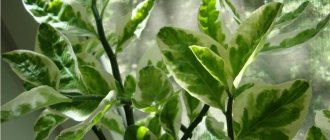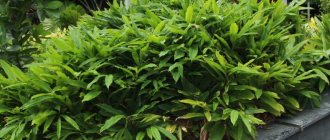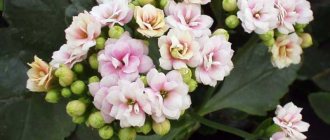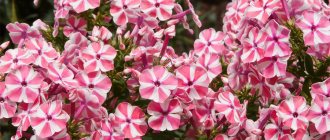Signs related to energy
You always need to maintain energy balance in your home.
If you miss this, then the residents simply will not want to return to the house, and all guests will be scared away by the negative energy of your home. If you want to maintain the comfort of home, then you simply need to acquire a mother-in-law’s tongue. Mother-in-law's tongue will not require special care from you. It is quite easy and simple to care for. According to experts, it will be able to independently adapt to any living conditions. The only caveat is that you must feed it with negative energy. For him, ideal conditions are when there is a scandal in the house, a person is angry, or he is in a bad mood. Its main feature is that it takes away negative energy from guests and residents, and in return gives positive emotions. Its leaves act as an antenna that allows all these manipulations with a person’s mood.
Sansevieria helps its owner get rid of enemies. If you have a person at work who has a negative attitude towards you, then it is best to bring a pike tail to the workplace. Folk omens about the mother-in-law's tongue flower say that it will help you remove ill-wishers from your life and help you tune in to the work process.
Types of Sansevieria (Sansevieria)
Remember the “mother-in-law’s tongue” flower? He is also a “pike tail”. This is a three-lane sansevieria (or sansevieria) - one of the tall species. It has green long sword-shaped leaves, the pattern of which resembles snake skin or a striped tiger. In a beautiful design it looks interesting and stylish.
Three-lobed Sansevieria
Indoor Sansevierias
They are tall (three-striped Laurenti), medium in height (Futura, Moonshine) and compact (Hanny varieties). Choose from miniature graceful rosettes measuring 15 cm to large ones 1.5 m tall.
Sansevieria species
There are variegated varieties with yellow streaks or borders. There are varieties with green leaves of different patterns and shades. There are dark, light, silver, plain, striped.
Varieties of Sansevieria Honey
Today many new varieties have been developed. Let's name the popular ones: large, cylindrical, Kirka, Duneri, Liberian, hyacinth, graceful. Flowers vary in width and shape of leaf blades.
Sansevieria with different leaves
Is it possible to keep Sansevieria at home?
Sansevieria (sansevieria)
There is an opinion that the plant is dangerous to keep at home. Actually this is not true. There is no scientific evidence to support the theory that it is dangerous for keeping at home. But there are scientific studies that prove the benefits of having a plant in an apartment.
Sansevieria affects gas exchange in the room and also saturates the air with negative oxygen ions. Thus, the air in the room becomes similar to the sea or forest. In addition, the flower absorbs harmful substances such as benzene. With the help of the plant, the influence of harmful substances from linoleum, chipboard and plastic is significantly reduced.
Whether to grow a plant in your home or not, everyone decides for themselves. But you definitely shouldn’t give up such a beautiful flower. After all, all beliefs and superstitions are nothing more than just myths and legends.
How can you fit a plant into the interior of an apartment?
With the correct placement of an indoor flower and the choice of a beautiful flowerpot, it can fit into any interior. The plant will look equally good on a windowsill, on bookshelves, shelving, on the floor and even in the bathroom. Everything depends only on the designer’s imagination.
Sansevieria in the interior: placement options and photos
Unpretentious houseplant
He doesn't care about the location in the house. When choosing a location, you should take into account the overall interior of the apartment.
Tall sansevieria will look impressive in a floor planter. The plant is erect and not spreading, which means it does not need much space. The pot may be low, then the plant should be chosen tall, and vice versa. The soil of the plant can be decorated with large stones or stone chips.
A low-growing plant is suitable as the basis of a flower arrangement. You can choose several types of one plant and combine them into similar, but separate pots.
Designers use a flower as an element of zoning a room: a rectangular partition leaves space for planting, and the soil is decorated with natural stones or sea pebbles.
Next you can see in the photo what the plant looks like in the interior:
In what cases is it not advisable to keep a culture at home?
There are no contraindications for keeping the plant in the house. The plant is dangerous if the leaves can be eaten by children or pets. Try to place the flower in a place inaccessible to children and animals who like to chew leaves.
Healing properties of sansevieria
Since ancient times, the Sansevieria flower has been actively used to treat many diseases. Its resilient leaves contain a large amount of active substances.
The juice of the plant helps get rid of sore throat, otitis, and inflammation of the genitourinary system. Compresses with leaves are applied to wounds and eczema for rapid healing.
But you need to prepare medicines with caution. The plant contains saponins, which are poisonous without treatment.
Sansevieria is recommended to be placed in any room where people spend a lot of time. It is believed that it purifies the air from harmful microbes and bacteria, absorbs radiation from electrical appliances, and has a beneficial effect on the atmosphere in the house.
How to care?
Caring for Sansevieria (Sansevieria) flowers at home, replanting, propagation
Caring for the cylinder at home is very simple. Even absolute beginners in gardening can cope with it, because the plant will survive both the only watering for a whole month and the absence of special procedures.
Top dressing
In principle, the cylinder can be grown without any fertilizing, but only in case of regular replanting, so that the plant does not find itself in a situation where all the nutrients in the soil have run out. However, in order to activate growth or avoid replanting, you can organize a fertilizer application system. This happens either once a month, or once every two weeks in the case of a dosage reduced by a couple of times.
Watering
Cylindrical Sansevieria prefers regular but infrequent irrigation. You can wait until the top layer of soil dries out before watering the plant. The cylinder is not afraid of dryness, but overwatering and waterlogging can be dangerous for it. If the soil mixture is selected correctly, watering can be carried out once every 4 weeks.
It is not necessary to spray the crop additionally, since dry air is not dangerous for it. However, you should clean the sheets of dust from time to time.
Disease Control
Although Sansevieria is immune to most common diseases, sometimes improper care can lead to symptoms of certain developmental disorders. For example, if the tips of the leaves dry out, this indicates that the plant is receiving too much water or is in too cold a place. The same care violations can lead to dark spots on the leaves themselves. In both situations, it is enough to simply normalize the irrigation system and move the bush to a warm place. A change in color to yellow is typical for sansevieria growing in a pot that is too small or without access to light rays.
Softening of the leaf at the base can result from liquid entering the center of the rosette and further development of a fungal disease. The fungus can be identified by the appearance of red spots with yellow edges.
Trimming
There is no need to form a cylinder. However, you will have to regularly trim damaged or diseased leaves. This is done using instruments that have been disinfected. If you want to create a weave yourself, you will have to choose young plants with densely growing soft leaves. Having formed a pigtail, it will need to be secured with soft twine or decorative twine. It is worth mentioning that if flowering occurs on each leaf, it is only once. Therefore, the already withered peduncle must be immediately eliminated.
Tips for growing and replanting sansevieria are waiting for you in the next video.
How to propagate sansevieria
This plant is easy to divide and even easier to grow from its leaves. It is enough to cut the leaves into small columns 4-6 cm high, dry the edges and immerse them in sand or substrate by a third at a slight angle - and after a while they will produce many new rosettes.
There is only one difficulty: the leaves of varieties with a bright border require rooting only of the colored parts, otherwise the offspring will be pure green. Therefore, green fabric is cut out from below in a semicircle for the cuttings, only the colored border is immersed in the soil.
Sansevieria can be divided at least with every transplant. It is better to carefully cut the roots, not forgetting to treat and dry the wounds. If desired, you can root individual side rosettes after releasing independent roots.
Related article:
Several undeservedly forgotten “Soviet” indoor plants
Sansevieria is easily propagated by cuttings
Home care
Ampelous bacopa: care, reproduction and preservation
Even a child can choose such an unpretentious indoor plant as Sansevieria.
Lighting
Good lighting is important only for variegated varieties of mother-in-law's tongue. It is recommended to place them on a southwestern or eastern window, where the color will appear especially brightly
If there is no suitable place, then you can safely grow plain varieties in the back of the room or on the north window.
It is recommended to move them closer to the light for at least 1–2 months a year or take them outside in the summer. During this time, a pair of new leaves are formed, which grow under the same conditions.
Temperature
Sansevieria adapts to a fairly wide range of temperatures - from 16 to 25 ° C
In summer, at higher temperatures, the pike tail will easily tolerate the heat and will not require additional attention. Important! In winter, the temperature should not be allowed to drop to 10 ° C, which will lead to frostbite of the roots and their rotting. The pike tail is able to develop at a constant temperature all year round. You will only need to create special conditions for wintering if you want to see how Sansevieria blooms
For this purpose, the temperature is reduced to 15 °C for 1 month.
How to water a pike tail
Mother-in-law's tongue gets along well with those who often forget to water the flowers. The hard leaves of Sansevieria just like it - even in summer you should not water the plant more than once a week.
In winter, you can moisten the soil only once a month, thereby reducing the ambient temperature.
Watering too frequently can cause rotting of the root system and the death of your pet. It is recommended to focus on the soil: it must dry completely to its entire depth.
Important! When watering, be sure to ensure that water does not get into the center of the outlet. Moisture will very quickly cause leaves to turn black and die
Humidity
One of the many advantages of keeping pike tail is that you don’t need to spray the leaves. The procedure can even harm the sockets if moisture flows into their base. For hygienic purposes, you can only wipe the leaves with a damp cloth, removing dust from them.
How to replant sansevieria
Although pike tail grows slowly, you should know how to replant sansevieria at home. A wide pot is selected for replanting, since the roots of the flower grow more to the sides than to the depth. In this case, the material from which the container is made is not important - plastic and clay flowerpots are acceptable.
Advice! For tall sansevieria, it is better to choose a heavy ceramic pot that will not tip over from overgrown foliage.
It is better to prepare the soil yourself from equal parts of leaf soil, turf soil and sand. The finished composition should be loose and highly nutritious. Of the ready-made substrates, pike tail is suitable for soil for succulents or cacti.
Relocation to a new pot is carried out using the transfer method:
- Water the plant for better extraction.
- Fill the new pot one-third full with drainage, with a layer of soil on top.
- Turn the pike tail over, holding it by the base, and shake it out of the pot.
- Remove softened or broken roots and dust the damaged area with charcoal.
- Place the plant in the center of the new pot and cover it with soil.
Sansevieria fertilizer
The recently transplanted mother-in-law's tongue does not need fertilizer for a long time. Fertilizing can be applied when the flower has been kept in the same substrate for more than six months or begins to wither.
Advice! Add additives only during the active growth phase in good lighting conditions. In partial shade, without the formation of new leaves, nutrients will not be absorbed and will only lead to a chemical burn of the roots.
You should water the flower with fertilizer no more than once a month, and fertilizers for succulents are best suited for this.
Transplantation and fertilization
It is better to plant pike tail in self-prepared soil. Sod is mixed with leaf soil and sand in a ratio of 2:2:1, respectively. Be sure to place drainage at least 3 cm thick at the bottom of the pot.
Sansevieria is replanted only when the roots begin to emerge to the surface. The diameter of the new pot should not exceed the previous one by more than 5 cm.
The roots of the plant grow wider. Therefore, it is preferable to take shallow containers.
- How to preserve and care for chrysanthemums in a pot in winter
How to take care of indoor flowers in the fall: useful tips and tricks
- How to choose a bouquet for March 8: the meaning of flowers and their quantity
Transplantation is carried out in the spring after flowering, since the next peduncle will appear when the roots occupy the entire volume of the pot.
The plant is fertilized monthly with liquid cactus product. The finished fertilizer is diluted with water to reduce the concentration of active substances.
If the mother-in-law's tongue is in a darkened corner, the frequency of fertilizing is reduced to once every 2-3 months, since excess fertilizer can lead to rotting of the roots and rosette.
Landing
Sansevieria can be grown not only indoors, but also in open ground, since it is very resistant to low temperatures. The main thing that is required from the grower is good drainage, since this species does not like large amounts of moisture.
The ability to withstand drought well has made the plant popular in arid areas as the main decoration of the landscape.
Sansevieria prefers full sun, but will grow successfully in light to moderate shade. However, some species with colored colors may not develop them if not given enough sun, meaning the leaves will remain just green without any gold edging. Moreover, too little light will result in weak growth and small bushes.
Over time, if the grower has chosen the planting site correctly, the plant begins to fill everything around it. In this case, there are three ways to deal with the problem:
- you can dig up shoots every 2-3 years;
- it is necessary to plant sansevieria in containers, which are then placed in the ground, thus they remain out of sight, preventing growth;
- install barriers several tens of centimeters into the ground, which prevent root growth.
The time for planting in the soil is early spring. This flower has no special requirements regarding the quality and fertility of the soil, so it does not require much attention. A small depression is made in the ground into which the bush is placed so as to cover the root collar with soil. The first watering is carried out, then the soil around is moistened no more than once a week and lightly.
Most amateurs and professionals grow sansevieria as a houseplant. She adapts perfectly to indoor life. It is best to place the pot in a sunny place, but even a room with little light is suitable.
For planting, you can use cactus potting soil or add coarse sand to regular sand to provide the quality drainage these plants need.
Some types of plants grow quickly, so they will need to be divided annually. For planting, you should use a container that is shallow but wide. The bushes have a shallow root system, but it grows well. The soil at the bottom of a deeper container retains moisture longer, which leads to root rot.
Replanting is done in the spring, at the same time you can fertilize the plant using a balanced composition (10-10-10 or 8-8-8). The second time, fertilizing is applied closer to the end of the growing season, that is, in August. The plant should not be fertilized in winter.
Kinds
There are about 70 species of Sansevieria and only 2 of them are grown at home. Among the rest, several options are most common.
- "White" . A variety that was selected in 1948. Among the distinctive characteristics, one can highlight the presence of white longitudinal stripes on the foliage, which alternate with dark green ones. This plant grows very slowly, the leaves are hard and straight.
- "Cylindrical" . Grows up to two meters in height. The foliage is dark green and has a dense groove in the middle. A thorn forms at the top due to the drying of the leaf.
- "Hanny" . Shows small bent leaves, from the side it very much resembles a vase. There is a subspecies "Golden Hunny" that has yellow stripes.
- “Silver Hunny” - similar in shape to the previous variety, but the foliage is light, a very attractive silver shade with a dark edging.
- "Laurenti" . The leaves are long, have transverse light stripes and a yellow edge. This species is often the basis for the development of new varieties.
- "Futura" . It differs from the Laurenti variety in having short and wide leaves; the stripe with a yellow tint on this plant is thinner.
- "Robusta" . It has no stripes, but has an interesting shape. The subspecies has very dark leaves and no pattern.
- "Moonshine" . A new variety with gray-green leaves that follow the shape of Futura.
- "Nelson" . The peculiarity of this subspecies is the presence of a velvety shine on the leaves, which are directed upward. The bush grows short but dense. It is better to propagate by rhizome to preserve its properties.
- "Silver Queen" . Shows silvery foliage in young plants with a small thin edge.
- "Compact" . From the outside it resembles Laurenti, but there is a slight curl at the tips.
- "Velvet" . The plant has an unusual shape, since the greenery is twisted into small tubes. The top part dries out over the years.
- "Bakularis" . It has cylindrical leaves that are very dense and sinewy. It does not like large amounts of moisture, the bush begins to rot.
- "Black Gold" . A classic option with dark foliage, completely unpretentious to growing conditions. It has a light border along the edges, the leaves are straight.
- "Hyacinth" . The bush is formed from 10-15 leaves, on the surface of which there are transverse strokes of emerald color.
- "Ayo" . It blooms in winter with small inflorescences that have an exquisite aroma. The leaves are short, collected in rosettes of 5 pieces.
- "Three-lane" . The plant does not have a stem; all shoots are attached to the rhizome. The plates can reach a height of up to one meter, although there are also dwarf subspecies. The flowers are very inconspicuous, but have a strong aroma.
Description of the plant
Sansevieria cylindrical differs from other representatives of its genus by its leaves twisted into a tube, growing directly from the ground.
Thanks to careful selection, it was possible to develop several varieties of this plant, which differ in the thickness and height of the leaf blades, location, shape and color of the stripes on them.
Among the most popular are Sansevieria Mikado, Spike, Spaghetti and Twister. The latter variety is unique in that its leaves retain the ability to bend, thanks to which the flower can be shaped like a braid.
Sansevieria cylindrical grows up to one and a half meters in height. The dark green leathery leaves have a pronounced longitudinal groove, and at the tip there is a point, which often dries out, turning into a thorn.
Light spots on the leaves form the typical striping pattern for the species. Depending on the variety, such spots can be wide or narrow. They also differ in shades: some have tones similar to the main color, while others contrast with it.
During flowering, Sansevieria cylindrica produces a peduncle, the length of which can reach 1 meter. White tubular flowers with pinkish tips are located evenly on it, in the form of a spike or a brush elongated along the length. Depending on the variety, the color of the peduncle itself can be light green, bright green or beige-pink.
Types of indoor sansevieria
Three-stripe Sansevieria (Sansevieria trifasciata) is the most popular species with flat and hard, growing vertically, decorated with transverse stripes and strokes, sword-shaped leaves up to 1.2 m high with a width of only 7 cm. They grow in medium-sized 6-8-leaf rosettes.
Shapes and varieties differ in the length of the leaves - from short (in flower-shaped rosettes) to giant giants - and shades of patterns, the presence or absence of a border on the leaves. Laurentii form has a thick yellow border, the Moonshine has almost white oval leaves, the Sensation Bantel has white stripes that almost hide the long narrow leaves, and the Silver Queen has silvery tall leaves.
Cylindrical Sansevieria (Sansevieria cylindrica) is a fashionable species with pencil-like cylindrical dark green leaves up to 2 cm in diameter and up to half a meter long, with a longitudinal groove noticeable only close up.
Read our detailed article about this species. Sansevieria cylindrica is the easiest houseplant to care for.
Sansevieria hahnii is a controversial cultivar of Sansevieria three-striped, which many scientists classify as a separate variety (rosette, rose Sansevieria, low, flower Sansevieria). Triangular, shortened leaves create a flower-like rosette.
Read more about this species in the article Sansevieria Hana - it will forgive any care mistakes.
Sansevieria trifasciata. © Desire Van Meulder
Sansevieria cylindrica. © Gärtner Pötschke
Sansevieria hahnii.
© daiquiridan Less common species include:
- Hyacinth Sansevieria (Sansevieria hyacinthoides) with lily-of-the-valley leaves, expanding at the top, up to 50 cm long with a reddish border, light stripes and wavy edges. Slightly larger wavy leaves with light specks are also characteristic of Sansevieria liberica.
- Kenyan hyacinth , or Sansevieria parva (Sansevieria parva) is a beautiful compact species up to 30 cm in height with rosettes of narrow pointed leaves similar to miniature yuccas and surprisingly large spikelets of inflorescences.
- Sansevieria kirkii is a beautiful species with leaves almost lying in a flower-shaped rosette, wide at the base, silvery-green with a brownish-white border and a coarsely toothed edge. There are several unexpected hybrid varieties with narrow, grass-like, straight leaves (for example, Friends ).
Sansevieria hyacinthoides. © sausagecemetery Kenyan hyacinth, or Sansevieria parva. © Agaveville
Sansevieria kirkii. © anka zietkiewicz
Home care
If the plant is grown or transplanted at home, then it is worth placing it in a place where there is moderately bright or diffused light for as long as possible. The position in front of the north window can be considered good. Although the plant tolerates the absence of light well, it helps to bring out the color on the leaves.
Be sure to let the soil dry completely before watering, and then wet it well until water flows through the drainage holes. The pot must drain before it is placed on the saucer. The soil should not be allowed to remain damp for a long time; watering is reduced to a minimum in winter.
The flower is valued for its interesting appearance. Although the most common variety is known as Mother-in-law's Tongue, other equally attractive varieties can be found on windows. Other varieties grow into compact rosettes and reach a height of up to 10 cm. Even with minimal care, this plant lives and pleases for many years, and sometimes seems almost invulnerable. Sansevieria is suitable for planting outdoors.
It is better to replant the flower and feed it once every 3 weeks throughout the summer. Too much fertilizer causes the leaves to start falling off. When there is flowering on the plant, it is worth caring for more carefully, watering it on time and wiping off the dust with a soft damp cloth. If any shoots are damaged or spoiled, they are cut off from the root. Planting a flower means acting very carefully so as not to damage the roots.
Several species of weeds are also serious pests in field flower growing conditions. The leaves need sufficient light, so taller plants should not develop around them. This also applies to grass. Research has shown that herbicides are quite effective in combating this problem, but they can also harm sansevieria.
Houseplant Sansevieria; how pike tail reproduces, flower care
Among gardeners there is a list of indoor plants that simply must be available. This list undoubtedly includes Sansevieria. This plant has several names, the most famous are sansevieria, pike tail, devil's tongue, Indian sword and mother-in-law's tongue.
Contents of the material
Description of the plant and its varieties
Due to the beneficial properties of sansevieria, almost all flora lovers try to have it. This houseplant is credited with medicinal properties. And externally, the indoor flower differs from its relatives in the absence of a stem. Quite wide, dense leaves with a pointed top extend from the root of the pike tail.
The size of the leaves and their color will depend on the varietal variety of sansevieria. It happens that the length of the foliage can reach 100 cm and above or, conversely, not exceed 15 cm.
Only at first glance it seems that this indoor flower is unpretentious. In order for the foliage to have a healthy appearance and pleasant gloss, the flower should be provided with proper care. Only then will the sansevieria bloom.
The pike tail flower belongs to the category of evergreen plants that are found in the wild in African and Asian spaces. The flower rosette originates in the rhizome, which reproduces according to the creeping principle. The dense foliage is covered with a waxy coating, which prevents excessive loss of moisture. For this reason, pike tail can withstand short periods without moisture. The plant also reacts normally to dry indoor air.
Breeders can count about 70 varieties of this plant, and almost every representative of the sansevieria genus can please the owner with flowering. Among the famous varieties I would like to note:
We also recommend reading:
- Craig;
- Pick;
- Hanni;
- Laurentia;
- Duneri.
Gallery: Sansevieria flower (25 photos)
How the pike tail blooms
The pike tail plant belongs to the category of decorative deciduous representatives of the flora, but even it can bloom. White-green inflorescences appear on a thin peduncle growing from a rosette. The moment the buds open occurs in the evening, and with the onset of dawn the buds close again. In addition to the unusual flowering time, it has distinctive features and the aroma of the inflorescences, strongly reminiscent of vanilla. Thanks to this aroma, Sansevieria becomes a center of interest for insects. You can expect Sansevieria to bloom after its roots are well rooted in the pot and the plant itself is well cared for.
Plant propagation
You can start propagating the plant at the end of spring or at the very beginning of summer.
Methods for propagating Sansevieria:
- side shoots;
- cuttings;
- root division.
The simplest and most effective method of propagation is to separate the side shoots from the mother plant and plant them in a separate flower pot. The flower container for these purposes is selected to be small in size, which will contribute to the rapid growth and development of the young flower. Since Sansevieria is replanted every 4 years, a pot should be chosen 2 cm larger in diameter than the previous one.
The plant can be propagated by root division by transplanting pike tail. To do this, you need to have a sharp knife at hand, take and use it to divide the root, trying to cause minimal damage to the foliage. Each divided part must have a growth point. It is recommended to treat the cut areas with crushed charcoal or activated carbon.
Subsequently, it is not recommended to frequently moisten the transplanted bushes so as not to provoke rotting. The ideal method of watering is to immerse the pot of sansevieria in a bowl of water at room temperature for 20 minutes. The water level should reach the middle of the pot. After this, the indoor plant is removed, placed on a pallet, wiped with a cloth and returned to its original place. In winter, such manipulations with a flower pot are recommended to be done no more than once every 10 days. In summer, the plant needs to be moistened more often.
Leaf propagation is carried out as follows: the shoot is cut into pieces 6 cm long, then dried for several hours, treated with Kornevin and planted in a fertile substrate. To create optimal conditions, it is advisable to cover the recessed short sheets with transparent plastic cups with holes for ventilation.
Useful medicinal properties
Fans of traditional medicine have discovered the choleretic properties of the pike tail flower. The leaves of the plant are also used as an anti-inflammatory and wound-healing agent. A peeled sansevieria leaf is applied to the ulcer, secured with a bandage and left overnight. This method allows you to speed up wound healing and relieve inflammation. It turns out that the Sansevieria leaf has beneficial medicinal properties, similar to another well-known home healer - aloe.
If the leaf of the plant is finely chopped and poured with boiling water, then such a drink can strengthen the immune properties of the body. During a period of rampant infections, such a drink will come in handy. In addition, sansevieria is also credited with diuretic, fungicidal and antiviral properties.
It has been noted that the presence of a pike tail in the house also affects the emotional background, bringing joy to the home.
Home care
Each individual indoor plant must be provided with the proper conditions for existence.
Sansevieria (pike tail) prefers sunlight, but can do without it, being close to the window. The location of the “mother-in-law’s tongue” in the shadow of the room will not contribute to its full development and full disclosure.
If the plant has variegated foliage, then in this case it is necessary to take into account the following recommendations. If there is a yellow color (stripes) in the foliage color, then the amount of direct sunlight must be reduced. If you ignore this advice, the variegated color will disappear very quickly and the leaves will turn green. And it is also not recommended to allow a lack of lighting, which will entail a stop in the development of indoor flowers. In the case of natural light, it is necessary to achieve a golden mean. When exposed to direct sunlight, burns will appear on the foliage, and then the yellow spots can only be gotten rid of by removing the leaves.
When choosing a container for an “Indian sword” you need to pay attention to the size and depth. The pot for the pike tail should be shallow and small, with a mandatory layer of drainage.
When choosing soil, you need to pay attention to its nutritional value and the presence of sand. You can put in a little effort and create the optimal soil composition for sansevieria yourself. To do this, mix leaf, turf soil and sand. In this case, the soil will not be too light and will not lead to overdrying of the substrate.
Sansevieria should be fertilized twice a month throughout the spring-summer season. The best fertilizers are mixtures for succulents. In their absence, you can safely use universal mineral compositions. If Sansevieria with a variegated color is grown at home, then an excess of nitrogen should be avoided. This mineral component promotes the production of chlorophyll, and this will allow all the leaves to turn a uniform green color.
When watering sansevieria, choose a dosage regimen. And also, when cleaning, do not allow liquid to get into the outlet when moisturizing. If the plant is kept in winter and its location is in a cool and shady room, then watering must be reduced.
You can avoid daily spraying, but periodically wiping the sansevieria foliage from dust with a damp cloth is highly recommended.
A comfortable temperature for keeping a pike tail is +21-28 C during the day and +16-20 C at night. Excessive air humidity in the room can be detrimental to the “Indian sword”.
If, as a result of unfavorable conditions, defects and damage appear on the foliage, you can get rid of them by cutting them with a sharp knife. Under other conditions of maintenance and care, Sansevieria does not need pruning.
What diseases and pests can plague sansevieria
The greatest harm to the plant can be caused by:
- thrips;
- mealybug;
- spider mite
The success of treating a plant at home will depend on the speed of detection of pests and the start of therapy. Evidence of the appearance of a mite on the plant will be white spots on the foliage. As soon as the presence of the pest is confirmed, the above-ground part of the indoor plant should be treated with Actellik.
A sign of the appearance of thrips are white spots and a grayish unhealthy shine on the foliage. And when a white coating appears, you can confidently judge the presence of a mealybug. If you do not get rid of this pest in time, the sheets will become deformed and fade irrevocably.
Sansevieria flower or pike tail
Attention, TODAY only!
cvetnik.me
Sansevieria propagation
Three methods are used to propagate sansevieria:
- growing from seeds;
- root division;
- use of cuttings.
The first method is practically not used due to the difficulty of obtaining seeds, because the plant blooms extremely rarely. If you still managed to get sansevieria fruits, the seeds are taken out of the berries and dried. Then they are sown on a sterile, slightly moist substrate. It is recommended to cover the container with the seeds with film and place it in a warm place. Here, flower growers face new difficulties, since sprouts often develop poorly or can simply rot in the soil if the humidity is excessive. Daily ventilation is necessary.
Dividing Sansevieria rhizomes
There are much simpler and more reliable methods of reproduction. One of them is dividing the rhizome, which is convenient to do during transplantation. A young Sansevieria will grow completely identical to the mother plant.
Procedure:
- Cut the rhizome with a sharp, disinfected knife into pieces, each of which should have leaves and roots. Make sure that in Sansevieria species with formed rosettes, each individual part has a rosette;
- The resulting parts are planted in pots with substrate and kept at a temperature of at least 20°C until they take new roots. When new leaves appear, it means that the roots are already well developed.
Important! The cut surfaces are treated with charcoal to avoid fungal infections. In addition to cutting the rhizome, you can separate the resulting side shoots or daughter rosettes
They must have leaves at least 5 cm long and first roots
In addition to cutting the rhizome, you can separate the resulting side shoots or daughter rosettes. They must have leaves at least 5 cm long and first roots.
How to root sansevieria without roots
The most popular propagation method for this is rooting cuttings from leaves.
Procedure:
The leaf of the mother plant is separated with a sterile knife near the surface of the soil. If it is small, you can use the whole one; long leaves are cut into several pieces no less than 5 cm long; The cuttings are dried for several days, and the cut, which will be immersed in the soil, is treated with Kornevin to stimulate root growth
For leaves cut into several parts, you need to pay attention to the direction of growth, otherwise the cutting will not be able to root. Plant pieces of leaf in the ground, deepening them by 1.5-2 cm. At the next stage, you need to know how to care for sansevieria, its leaf cuttings
The substrate where planting is carried out should be moist, but not wet. It is constantly maintained in this state; The container with cuttings is placed in a warm, bright place at a temperature of at least 20°C. It is better if it is around 25°C. You can cover the top with film, but do not forget about ventilation. Patience will be required. It may take more than a month before the first shoots appear; As soon as the sprouts appear on the surface, the leaf cutting itself can be removed and after a couple of months the young plants can be planted in separate containers.
Rooting leaf cuttings
Important! In offspring propagated in this way, the color of the leaves will turn green, and the variegation of color will disappear if it was present in the mother plant
Sansevieria in the interior | House, garden, vegetable garden
Sansevieria has been labeled as a simple plant, and it is rare to find this plant in all its glory in interior spaces.
And if you succeed, then you cannot take your eyes off his sculptural appearance. Skilfully used in the decoration, the skyward leaves of sansevieria amaze the imagination with the graphics of their shapes and patterns.
Most often you can find Sansevieria trifasciata, which has fleshy sword-shaped leaves with transverse stripes.
Its variety is especially popular - Sansevieria Lawrence with a bright yellow border along the edges of the leaves. Sansevieria with short and wider leaves collected in a rosette (S.hahnii) is also common.
Sansevierias are easy to grow and unpretentious plants; they tolerate low light, dry air, and temperature changes. But if you place them in a bright place, periodically wipe their leaves and feed them, they will sparkle with brighter colors. And they will even delight you with fragrant delicate greenish-white flowers blooming in groups on a high peduncle.
Sansevieria in the interior
A composition of several plants planted in one wide container looks stylish. Three-lane sansevieria, planted in a long narrow container, makes a wonderful “green fence”. By combining tall and short sansevieria, you can create original compositions. Other articles on landscaping: Radermachera chinensis for the interior Philodendrons in the interior Monstera in the interior
READ ON THE TOPIC:
ziz-fackt.ru
Possible difficulties
Sansevieria may experience the following problems: - Rotting of the base of the leaves and rhizomes. - Yellowing of leaves. - Appearance of dry ends. - The appearance of pests.
If the leaves begin to soften or the rhizomes rot, it means that the watering is too abundant. In order to save the plant, it should be removed from the container, the diseased parts should be removed, the sections should be sprinkled with activated carbon and the specimen should be planted in new soil. In advanced cases, it will be necessary to restore Sansevieria by propagating and separating healthy shoots.
Sansevieria photo:
Rotting of the root neck can also occur with prolonged hypothermia, so do not allow the temperature to drop below 12 degrees. Sansevieria sometimes develops brown spots that spread from top to bottom. The disease is not infectious; you can maintain a decorative appearance by carefully trimming the ends.
Sansevieria is an ideal plant for interior decoration. For its ease of care and beautiful leaf shape, it is loved not only by flower growers, but also by designers.
Problems in growing sansevieria
- If there are signs of the beginning of yellowing of the leaves, do not rush with pruning: only completely affected leaves are completely removed; in others, only the damaged part is cut off.
- For the stability of varieties with long leaves that have not yet created a stable group, sometimes supports are needed, otherwise the rosettes “break out.”
- Any strong fluctuations in temperature or air humidity, a sharp shift into dense shade, or, conversely, into the sun, provoke the appearance of spots on the leaves and increase sensitivity to dampness.
- Sansevierias are prone to rotting if they are over-watered, over-cooled or too deep when planted.
- Sansevieria in a weakened state can suffer from scale insects or mealybugs, which must be combated mechanically and with insecticides.
Sansevieria looks best in the interior on the floor or at least at the height of the windowsill. It is appropriate as a visual divider and in zoning, as a complement to the boundaries between the functional areas of rooms, near massive furniture and passages. Sansevieria grows well in dense groups, so it is often used to create large dividers in indoor flower beds. It can be combined with other plants in succulent ensembles.
Caring for Sansevieria at home
Each plant has its own characteristics, as well as advantages and disadvantages. Before you decide to decorate your home with this or that flower, first try to find out in more detail how to care for it and what it needs for normal development and growth. And then think about whether you can grow it or not.
The pike tail differs from many other indoor plants in that it is not demanding in care and at the same time has a spectacular appearance. Features of cultivation:
- Sansevieria is fed very rarely, only once a year. However, if feeding is more frequent, the flower will react positively to this.
- It feels best on a windowsill because it needs plenty of natural light. At the same time, it can be both cool and warm on the windowsill.
- The midday scorching rays of the sun can leave burns on the foliage; therefore, windows that receive direct sunlight only in the late afternoon are ideal for growing pike tail.
- Regular stagnation of water in the root system can destroy a flower.
Temperature and humidity
For a plant, it doesn’t really matter what the temperature and humidity in the room are. But at the same time, you should not allow the room to be cooler than 16 degrees during the cold season, as this will negatively affect the appearance of the bush. Also, to preserve its decorative appearance, do not forget to systematically wipe the foliage with a damp sponge, which will remove dust from it.
Watering
In order for sansevieria to grow and develop normally, it must be properly watered. To understand when to water a flower, you can purchase a humidity indicator at a specialty store. Distilled or rainwater is best suited for watering a flower, but you can also use well-settled tap water. It must be at room temperature. In winter, the frequency of watering depends on the air temperature in the room: the colder the room, the less often you need to moisten the substrate in the pot.
Sansevieria transplant
The pike tail is replanted if necessary, when the root system completely fills the flower pot. On average, young bushes undergo this procedure once every 2 years, and adults - once every 3 years. Replanting sansevieria is easy, but do not forget to prepare the correct soil mixture for this. It is not recommended to use ordinary garden soil for this; a ready-made soil mixture sold in a specialized store is best suited for replanting. Its approximate composition should be: turf and leaf soil, as well as sand (2:1:1). The purchased ready-made soil mixture may also contain fine gravel and perlite.
Transplantation is carried out only when roots appear from the drainage holes. This means that the root system is very crowded in the pot. A suitable flower pot should have thick walls, preferably clay. The fact is that a powerful root system can tear thin walls, and long, heavy foliage can overturn a light pot. Also, a container suitable for transplantation should not be very high, but quite wide. Don't forget to make a good drainage layer at the bottom of the pot.
Top dressing
Pike tail needs to be fed only in spring and summer once every 30 days. Liquid mineral fertilizer for cacti or decorative deciduous crops is well suited for this. Do not add too much nitrogen to the substrate, as this may harm the flower. Experts advise using a nutrient mixture whose concentration is two times weaker than that recommended by the manufacturer (see instructions). If you are growing a species that has a pattern on the foliage, then the fertilizer concentration should be three times less than that recommended by the manufacturer. If you feed it with a more saturated solution, then because of this the foliage may become monochromatic.
Growing conditions for indoor sansevieria
Sansevierias adapt well to shading, and you can place them in rooms as you wish. As long as temperatures remain within room temperature, they grow well in any conditions.
Lighting and placement
Diffused, without direct rays, bright lighting or light partial shade is considered ideal for sansevieria. But all sansevieria can grow in the shade, feeling great in the interior. The degree of shading determines the risk of color loss: variegated stripes and shades are preserved only in well-lit areas.
Plants can bloom only when kept in bright light, but for the sake of such a goal they rarely sacrifice the opportunity to decorate the interior. Sansevieria react to artificial lighting in the same way as to natural lighting.
Temperature and ventilation
Sansevieria are thermophilic and cannot tolerate temperatures below 16 degrees even in winter. Sansevieria are not afraid of drafts without hypothermia, as well as temperature changes. In summer, sansevieria can be taken out into the fresh air, decorated with terraces and balconies, protecting it from precipitation.
Sansevierias adapt well to shading and you can place them in rooms as you wish. © El Mueble
Rules for caring for a blooming plant
It has already been said how to care for this plant before flowering, after it and at normal times. But what kind of care should be taken during the flowering period? It's not really that different.
- From time to time it is necessary to loosen the soil in the pot.
- You need to water as the soil dries out.
- Feeding should be done about once a month.
It is also necessary to provide the sansevieria with a sufficient amount of light so that it is not exposed to direct sunlight.
Sansevieria is a very unpretentious and easy-to-care plant. If you follow all the rules described above, it will delight you with its flowers for a long time.
If suddenly you did everything correctly, but the “pike tail” never bloomed, do not be upset, perhaps your type of plant does not bloom every year or it is simply resting.
Description
In nature, Sansevieria is most often found in Africa and Indonesia. In total, this plant has no more than 60 species. About ten varieties of Sansevieria are grown in apartment conditions, and the most popular among gardeners is the three-striped one. The photo of Sansevieria shows that this is the most unusual type of plant, which attracts with its beauty and variegated, long leaves.
This plant is popularly called “pike tail”. If the conditions in which Sansevieria grows are favorable, then flowers bloom on it, but even with the most suitable temperature and humidity parameters, the buds are small and barely noticeable.
Sansevieria extract is used in the production of medicines, cosmetics and hygiene products.
Plant propagation
The easiest way to propagate Sansevieria is by division. Thus, the plant retains all vital functions, and the new shoot is immediately ready for planting in the soil.
If there is no need for reproduction, then Sansevieria should still be divided periodically. This is necessary in order to thin out a bush that is too dense and give the plant the opportunity to develop.
Diseases and pests
All crops need periodic inspection; monitoring Sansevieria is extremely important. The plant itself will indicate an unhealthy state by displaying certain signs:
- If the leaves turn yellow, this means that the watering regime has been disrupted;
- The leaves are rotting - you need to pay attention to the air temperature;
- The appearance of white marks on the leaves indicates the negative influence of the sun;
- Spots on the roots occur from excessive moisture or insufficient light.
The plant can be restored if the right living conditions are provided for it. Affected bad roots must be removed immediately, normal parts must be kept in the air to dry and planted in renewed soil.
Pests that adversely affect the health of sansevieria are controlled using a soap solution and a napkin. Thrips, spider mites and scale insects die if the plant is wiped with such a product or a special composition purchased at the store. With proper care, Sansevieria will delight you with its power for a long time, fill the space with positive energy, decorate it with unique floral luxury, and surprise you with its resilience and love of life.











